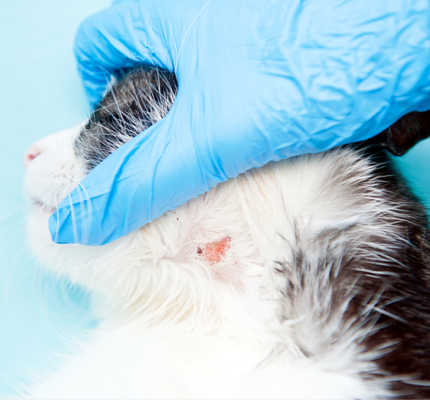– by Tania Sigurdson, PVHS Education Chair
The first time I heard about ringworm – I assumed it involved worms. Of course I did – it is right in the title! I was very surprised that ringworm has literally nothing to do with worms at all. Instead, it is a highly contagious fungal infection that affects skin, hair, and nails in both people and animals. It gets its name from the circular shape that the fungal rash develops into. While animals can give ringworm to humans, infected humans can also give ringworm to their pets or animals around them. As such, ringworm is a real risk to our family pets at home and to our shelter at the Pembina Valley Humane Society. We work very hard at the shelter to prevent the spread of ringworm including strict sanitizing guidelines and quarantine protocols. As pet owners, we need to also be aware of ringworm, what it is, how to prevent it, and how to treat it if you or your pets contract it.
Oakhurstvet.com’s blog site reported that “ringworm in pets is common, although cats are typically diagnosed more than dogs. Research shows that about a quarter of human
ringworm infections are connected to an organism that causes
ringworm in cats” and
vetcal.co.nz points out that “ringworm is more common in puppies and kittens than adult cat and dogs.” It is always a good idea to be cautious around stray cats/kittens as they may be carrying
ringworm untreated.
chla.org suggests that “proper handwashing and skin care is important in preventing
ringworm.”
So how do you or your animals catch catch ringworm? Foundanimals.org suggests that ringworm is transferred by direct contact with an infected animal or human and can even be transferred through touch surfaces such as kennels, toys, brushes, or animal beds.
What are the symptoms of ringworm? Some infected with ringworm are asymptomatic but more commonly, there is a circular rash, hair loss at the rash site, or itchy irritated skin. Due to the highly contagious nature of ringworm, it is very important to get checked by a vet/doctor if you thing ringworm may be in your home. Once diagnosed, it is VERY important to follow all the directions of the medical practitioner. You want to make sure you are moving swiftly to stop the spread and begin treatment. Any animals with ringworm need to be isolated and kept in quarantine while recovering.
Ultimately the best care you can give to your pets is daily love and attention. By frequently spending time cuddling and engaging with your animals you will be more likely to notice irregularities in their health, appearance or behaviours early. Early detection allows you to bring those concerns to the attention of your vet in order to ensure early diagnosis and treatment and a speedy path to recovery. A healthy fur family is a happy fur family!
Last modified: October 7, 2023

